标签:redirect margin methods lan div round scroll 文件 ops
github地址:vue-framework-wz
线上体验地址:立即体验
闲扯再多不会用也没白搭,这节课我来带大家直接上手框架,体验到简单方便之后你就会爱上这个框架欲罢不能的。
首先跟所有的vue项目一样,两种方式,一种去项目github地址:vue-framework-wz上下载代码包到本地,或者使用
git clone https://github.com/herozhou/vue-framework-wz.git
无论哪种方式,只要我们能够拿到整个代码包就行。在我们代码包的根目录下打开命令行,执行如下命令:
npm install --registry=https://registry.npm.taobao.org
建议大家最好使用这样的方式,cnpm总是会出现各种奇怪的bug。
等到依赖安装完成之后我们运行
npm run dev
然后在浏览器中输入http://localhost:9001,就可以直接看到我们的主界面了。 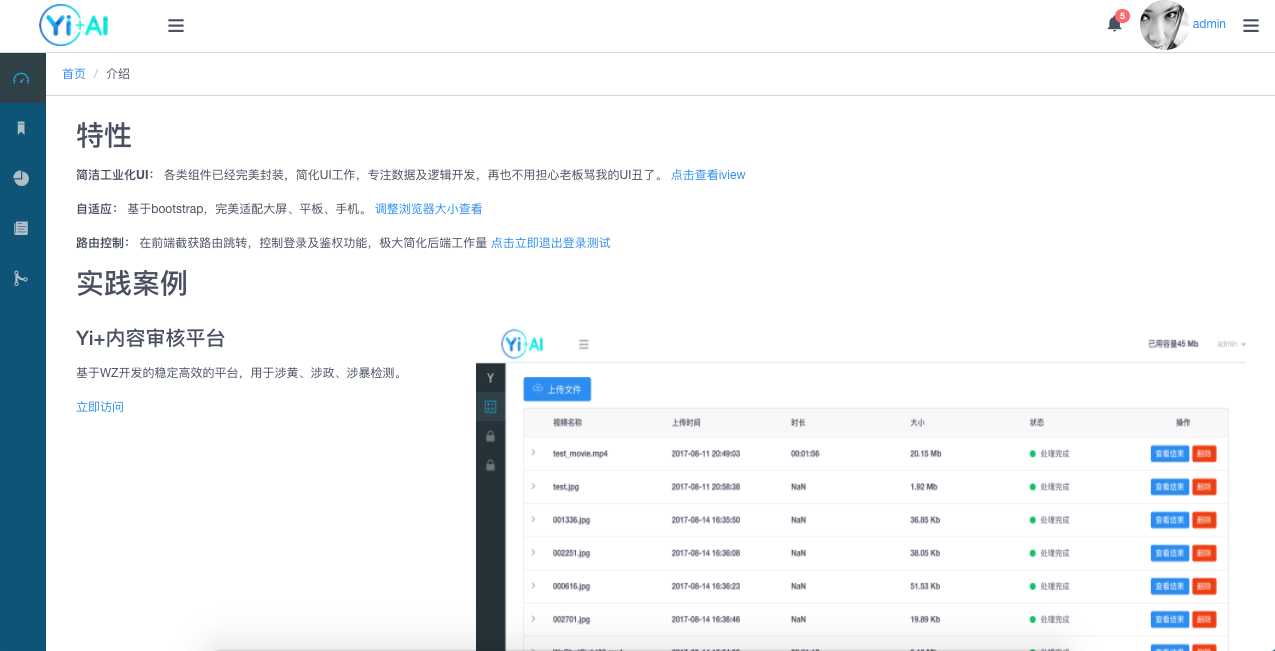
这是一个很粗糙的首页,我们接下来要学习如何做一个自己的界面。
打开编辑器,进入到vue-framework-wz/src/views文件夹下,新建一个vue文件,名字就叫做wz.vue,然后定义好一个vue组件的dom模板,如下图。

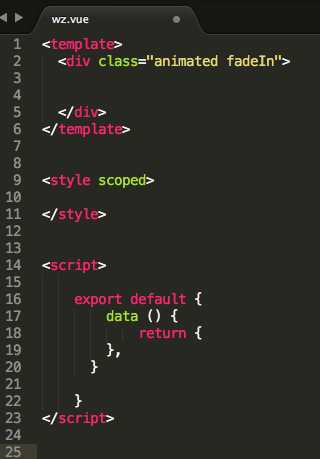
我们写点什么呢?先写一个简单标题能看到效果吧。
<template> <div class="animated fadeIn"> <h3>框架在手,天下我有</h3> <p>好用的框架决定了一个程序员的效率</p> </div> </template>
如果我们想要有自适应的效果怎么办?加上Row行组件和Col列组件,并设置好Col的属性
<template> <div class="animated fadeIn"> <Row> <Col :sm="12" :md="12" :lg="12"> <h3>框架在手,天下我有</h3> <p>好用的框架决定了一个程序员的效率</p> </Col> </Row> </div> </template> <script> export default { data () { return { } } } </script>
这样就很简单的做好了一个页面,接下来就要配置路由了,进入到vue-framework-wz/src/router/index.js文件,把我们的组件引入进来,然后在下面配置好我们的路由,如下所示。
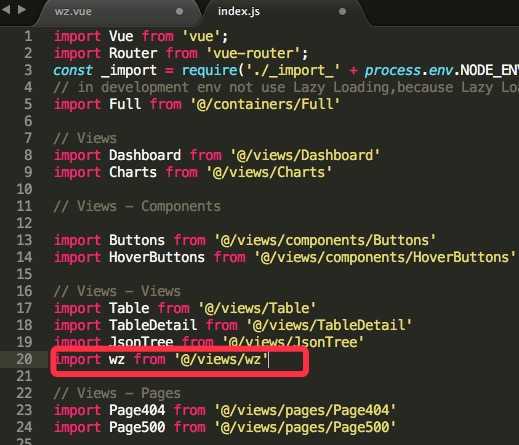
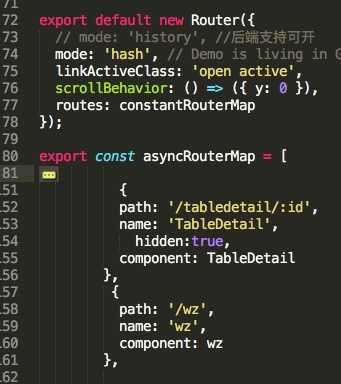
完整index.js代码
import Vue from ‘vue‘; import Router from ‘vue-router‘; const _import = require(‘./_import_‘ + process.env.NODE_ENV); // in development env not use Lazy Loading,because Lazy Loading large page will cause webpack hot update too slow.so only in production use Lazy Loading import Full from ‘@/containers/Full‘ // Views import Dashboard from ‘@/views/Dashboard‘ import Charts from ‘@/views/Charts‘ // Views - Components import Buttons from ‘@/views/components/Buttons‘ import HoverButtons from ‘@/views/components/HoverButtons‘ // Views - Views import Table from ‘@/views/Table‘ import TableDetail from ‘@/views/TableDetail‘ import JsonTree from ‘@/views/JsonTree‘ import wz from ‘@/views/wz‘ // Views - Pages import Page404 from ‘@/views/pages/Page404‘ import Page500 from ‘@/views/pages/Page500‘ /* login */ const Login = _import(‘login/index‘); /* dashboard */ /* permission */ // const Permission = _import(‘permission/index‘); Vue.use(Router); /** * icon : the icon show in the sidebar * hidden : if hidden:true will not show in the sidebar * redirect : if redirect:noredirect will not redirct in the levelbar * noDropdown : if noDropdown:true will not has submenu * meta : { role: [‘admin‘] } will control the page role **/ export const constantRouterMap = [ { path: ‘/login‘, component: Login, hidden: true }, { path: ‘/pages‘, redirect: ‘/pages/p404‘, name: ‘Pages‘, component: { render (c) { return c(‘router-view‘) } // Full, }, children: [ { path: ‘404‘, name: ‘Page404‘, component: Page404 }, { path: ‘500‘, name: ‘Page500‘, component: Page500 }, ] } ] export default new Router({ // mode: ‘history‘, //后端支持可开 mode: ‘hash‘, // Demo is living in GitHub.io, so required! linkActiveClass: ‘open active‘, scrollBehavior: () => ({ y: 0 }), routes: constantRouterMap }); export const asyncRouterMap = [ // { // path: ‘/permission‘, // component: Layout, // redirect: ‘/permission/index‘, // name: ‘权限测试‘, // icon: ‘quanxian‘, // meta: { role: [‘admin‘] }, // noDropdown: true, // children: [{ path: ‘index‘, component: Permission, name: ‘权限测试页‘, meta: { role: [‘admin‘] } }] // }, { path: ‘/‘, redirect: ‘/dashboard‘, name: ‘首页‘, component: Full, hidden:false, children: [ { path: ‘/dashboard‘, name: ‘介绍‘, icon:‘speedometer‘, component: Dashboard }, { path: ‘/components‘, name: ‘组件‘, redirect: ‘/components/buttons‘, icon:‘bookmark‘, component: { render (c) { return c(‘router-view‘) } }, children: [ { path: ‘buttons‘, name: ‘按钮‘, icon:‘social-youtube‘, component: Buttons, hidden:false, }, { path: ‘hoverbuttons‘, name: ‘悬停特效按钮‘, icon:‘wand‘, component: HoverButtons } ] }, { path: ‘/charts‘, name: ‘图标‘, icon:‘pie-graph‘, component: Charts, }, { path: ‘/table‘, name: ‘表格‘, icon:‘ios-paper‘, component: Table, meta: { role: [‘admin‘] } }, { path: ‘/jsontree‘, name: ‘JSON视图‘, icon:‘merge‘, component: JsonTree }, { path: ‘/tabledetail/:id‘, name: ‘TableDetail‘, hidden:true, component: TableDetail }, { path: ‘/wz‘, name: ‘wz‘, icon:"social-html5" component: wz }, ] }, { path: ‘*‘, redirect: ‘/pages/404‘, hidden: true } ];
然后打开我们的浏览器进入到http://localhost:9001/#/wz
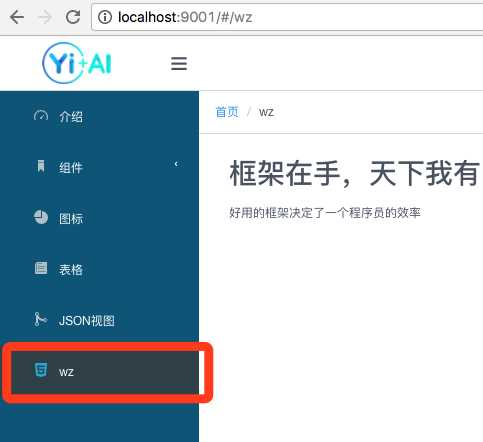
页面就显示出来了,而且侧边栏已经自动遍历可访问的路由生成列表项了。
很方便吧?
接下来我们进阶一下,看看如何做一个表格。
首先加入Table标签,
<Table :columns="columns1" :data="data1"></Table>
再配置列和data属性:
export default { data () { return { columns1: [ { title: ‘姓名‘, key: ‘name‘ }, { title: ‘年龄‘, key: ‘age‘ }, { title: ‘地址‘, key: ‘address‘ } ], data1: [ { name: ‘王小明‘, age: 18, address: ‘北京市朝阳区芍药居‘ }, { name: ‘张小刚‘, age: 25, address: ‘北京市海淀区西二旗‘ }, { name: ‘李小红‘, age: 30, address: ‘上海市浦东新区世纪大道‘ }, { name: ‘周小伟‘, age: 26, address: ‘深圳市南山区深南大道‘ } ] } }, }
这样简单的表格就做好了
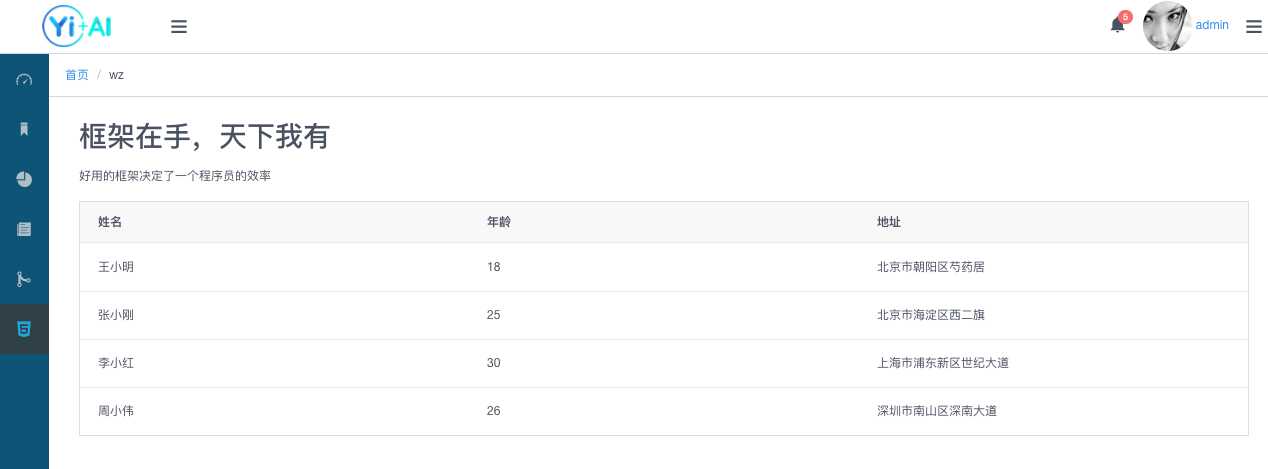
怎么在表格中加入按钮呢,比如查看,删除?
这就用到vue的render函数了。
在columns1中加入一个新的属性,是一个render函数。
{ title: ‘操作‘, key: ‘action‘, width: 150, align: ‘center‘, render: (h, params) => { return h(‘div‘, [ h(‘Button‘, { props: { type: ‘primary‘, size: ‘small‘ }, style: { marginRight: ‘5px‘ }, on: { click: () => { this.show(params.index) } } }, ‘查看‘), h(‘Button‘, { props: { type: ‘error‘, size: ‘small‘ }, on: { click: () => { this.remove(params.index) } } }, ‘删除‘) ]); } }
如果对render函数很陌生的话,移步vue文档学习一下render函数。
然后我们加入一些功能函数,实现查看和删除功能。
methods: { show (index) { this.$Modal.info({ title: ‘用户信息‘, content: `姓名:${this.data1[index].name}<br>年龄:${this.data1[index].age}<br>地址:${this.data1[index].address}` }) }, remove (index) { this.data1.splice(index, 1); } },
当我们点击查看就会出现一个对话框,点击删除就会移除这一行
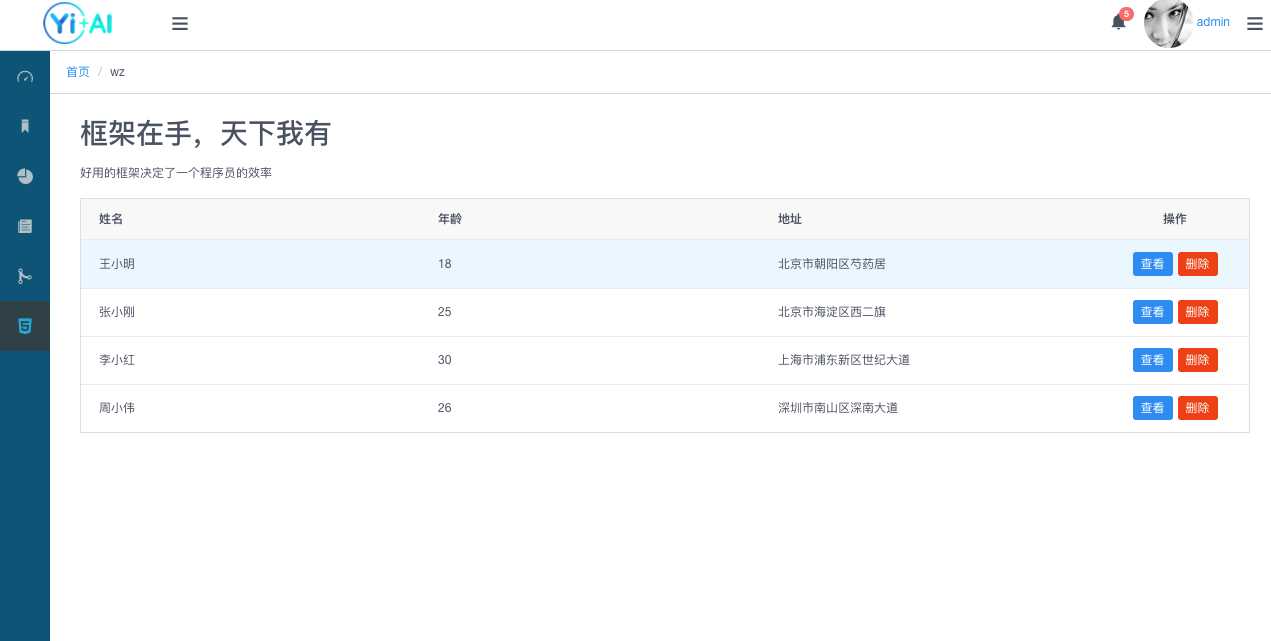
后续教程内容:
登录鉴权、路由、自己动手封装UI组件
github地址:vue-framework-wz
线上体验地址:立即体验
标签:redirect margin methods lan div round scroll 文件 ops
原文地址:http://www.cnblogs.com/herozhou/p/7441702.html